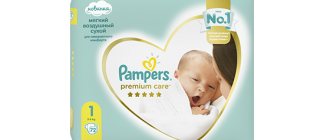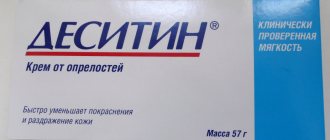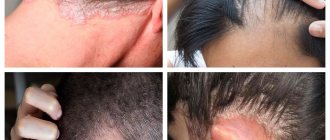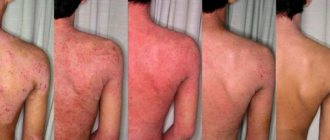General information
Diaper dermatitis (syn. diaper dermatitis, diaper rash in newborns, diaper rash) in pediatric practice is one of the most common skin lesions in children of the first year of life. Diaper dermatitis was first described more than 100 years ago, and the term “diaper dermatitis” first appeared in the early 1960s, coinciding with the introduction of the production/use of disposable diapers. Diaper dermatitis (ND) is an inflammatory reaction of the baby's skin in the area of contact with the diaper/diaper, manifested in the form of irritation, redness, rashes or swelling of the skin. The photo below shows what diaper dermatitis looks like.
In the outpatient practice of a dermatologist, the incidence of the disease in the population of infants is on average 15%, debuting in the age interval of 3-12 weeks with a peak incidence at the age of 6-12 months. At the same time, the disease is more often diagnosed in girls. The incidence of diaper dermatitis among newborns who are breastfed is lower, which is due to the lower enzymatic activity of their feces/urine. Children with a tendency to allergic reactions, those receiving artificial feeding, and those who have undergone a long course of antibiotic therapy are more likely to suffer.
The disease occurs much less frequently after 3 years of age, which is due to the “maturation” of the protective functions of the skin and the child’s acquisition of hygienic skills. Diaper dermatitis in older children occurs mainly in those who need to wear diapers for a long time (with urinary/fecal incontinence).
The development of the disease is largely facilitated by the peculiarities of the skin in infants/young children, which functions in a state of unstable equilibrium and cannot fully perform a protective function. The main ones are:
- immaturity of the skin (fragility of the basement membrane, thinness/vulnerability of the epidermis, underdevelopment of the connective component of the dermis);
- reduced skin hydration (relatively low moisture content);
- high skin pH in skin folds;
- imperfect immune/thermoregulatory function;
- tendency to be easily injured.
In addition, reduced humoral/cellular immunity in the early periods of life and an insufficiently formed water-lipid mantle on the surface of the skin of newborns/increased alkalinity of the skin, in particular in intertrigenous areas, contribute to an increased susceptibility of the skin to infection by microorganisms that easily penetrate the damaged epidermal barrier. Also, the cause of prolonged inflammation, accompanied by excoriations , severe itching and the addition of a secondary infection, are metabolic disorders.
Diaper dermatitis in a newborn is provoked by a lack of skin breathing (greenhouse effect), wet diapers, irregular/improper hygiene procedures, and infrequent washing of diapers. The severity of the disease can vary widely: from local, mild irritation from diapers to deep/extensive infection of the skin.
Despite the good study of the ethology/pathogenesis of the rash in the diaper area, as well as the factors contributing to its development, the problem is still relevant and common in children of the first year of life.
Losterin for diaper dermatitis
In the complex treatment of diaper dermatitis in children, zinc-naphthalan paste “Losterin” is used. The paste is well suited for wounds and ulcerations with signs of weeping; it contains 2 main components:
- deresined naphthalan: resinous compounds have antiphlogistic, soothing, antipruritic and drying effects; have an immunocorrective effect, as a result of which they also have an anti-inflammatory and desensitizing effect;
- zinc oxide: has adsorbing, astringent, soothing and drying properties; relieves signs of inflammation and inhibits the proliferation of pathogenic microorganisms; improves normal cell proliferation and promotes healing of microcracks.
Zinc-naphthalan paste Losterin can be prescribed as part of a complex treatment of dermatitis, used as monotherapy during the rehabilitation period, and also used for the purpose of prevention and maintenance of results.
Pathogenesis
The pathogenesis of the disease is a cyclical process, at the beginning of which there are factors that have a damaging effect on the skin: physical (friction / high humidity), chemical (urea breakdown products / enzymes of feces and bacteria), and biological (microbial) factors. As a rule, the pathological process is triggered by an increase in skin moisture, which is caused by prolonged/frequent contact of the skin with wet diapers/diapers. This is accompanied by an increase in the coefficient of friction, which contributes to its mechanical damage.
Against this background, skin permeability increases and sensitivity to chemical and microbial damaging factors increases sharply, among which lipase / protease (stool enzymes) play a special role. Their adverse effects on the skin are caused by the loosening of all layers of the epidermis and connective tissue matrix and, as a consequence, an increase in the permeability of the dermis. The adverse effect of fecal enzymes increases significantly when they are combined with urine, from which ammonia urease , synthesized by fecal microbes . In turn, an increase in ammonia concentration increases skin pH and activates protease/lipase and increases the toxic effect on the skin, leading to accelerated destruction of the epidermal barrier
Insufficient/defective care of the baby's skin and the lack of air circulation under the diaper, creating a sealed environment, contributes to maceration of the skin and the rapid penetration of irritants and microorganisms into and through the epidermis. Factors contributing to the development of diaper dermatitis are schematically shown below.
Also, an increase in humidity and pH of the skin contributes to the increased reproduction on the surface of the skin of microorganisms of the genus Candida albicans, gram-positive/gram-negative flora (Proteus/Pseudomonas aeruginosa), that is, the inflammatory process “under the diaper” can be enhanced by an infectious component, which affects clinical manifestations and the degree of their severity .
Precautionary measures
Before using such products, a mandatory consultation with a pediatrician or dermatologist is required. The components may have a neutral effect on the health of an adult, but they will cause an allergic reaction in a child.
Before use, the product is tested on a small area of skin. If there is no allergy, then treatment begins. You must always monitor the child’s condition to avoid negative consequences.
Classification
There is no uniform classification. In practice, primary and secondary diaper dermatitis are distinguished. In turn, primary dermatitis is divided into:
- Uncomplicated , developing due to the individual characteristics of the constitutional development of the child’s skin, defects in care, as well as under the influence of various metabolic processes (for example, ammonia irritation).
- Complicated . It develops when bacterial (streptococcal, staphylococcal) flora is attached, infection with Candida albicans (candidal dermatitis) or viral infection (herpetic).
Depending on the predominance of provoking factors, several types of diaper dermatitis are clinically distinguished:
- Diaper dermatitis, formed as a result of mechanical action (friction) and damage to the baby’s skin by the diaper material. In this case, damage to the protruding surfaces of the skin adjacent to the diaper/diaper is typical. The folds of the skin are clean.
- Contact irritant diaper dermatitis. It is localized mainly in the anal area with the involvement of the skin of the inguinal/intergluteal folds, abdomen and thighs in the inflammatory process.
- Develops when there is a defect in care—prolonged contact of the child’s skin with urine/feces (as a result of bowel dysfunction).
- Intertriginous dermatitis (complicated diaper dermatitis), which develops mainly as a result of infection with Candida albicans (candidal diaper dermatitis).
Causes
Diaper dermatitis is a polyetiological disease. A complex of directly irritating, provoking factors acting on specific background conditions of the body plays a significant role in the development of the disease. Among the main etiological factors it is customary to highlight:
- mechanical factors (high humidity/friction);
- chemical factors (bacterial/stool enzymes, urea breakdown products);
- infectious factors of bacterial (streptococcal, staphylococcal), fungal and viral nature.
Factors that provoke the disease include:
- Defects in the hygienic care of a child’s skin (improper treatment, refusal to bathe, infrequent diaper changes, etc.).
- Concomitant diseases (increased sensitivity to allergens , atopic / seborrheic dermatitis ; immunodeficiencies , diarrheal syndrome , etc.).
Predisposing (background) factors include constitutional/anatomical and physiological characteristics of organs and systems, including the skin, characteristic of young children (thin layer of the epidermis, insufficient connection between the epidermis and dermis, increased humidity and high vascularization of the skin, underdeveloped sweat glands), which determines the slight vulnerability of the skin and contributes to the development of the inflammatory process in it.
The reasons for the complicated course of diaper dermatitis (candidiasis) is the creation of a “greenhouse effect”, since diapers are poorly permeable to air, which increases the level of CO2 (carbon dioxide) and creates favorable conditions for the proliferation of fungi (candida/dermatophytes). When unfavorable factors appear (immunodeficiency states, taking antibiotics), fungi begin to actively multiply and synthesize proteases and hemolysins, causing manifestations of candidiasis. In most cases, fungi are an endogenous infection and, less commonly, infection occurs through household contact from a sick/healthy carrier.
Children at risk include:
- With a tendency to food allergies and other allergic diseases.
- With endocrine pathology.
- Mothers who are predisposed to allergic reactions.
- Exceeding normal body weight.
- With metabolic disorders.
Symptoms
Manifestations of diaper dermatitis are characterized by varying degrees of symptom severity. At the initial stage, clinical symptoms are represented predominantly by acute inflammatory edematous confluent erythema , with a clearly defined edge localized in the area of contact between the skin and the diaper - in the inguinal/intergluteal folds, lower abdomen, genitals, buttocks area (irritation from diapers). Then the inflammatory process spreads to the skin of the thighs and overlying parts of the abdomen/back, taking on a more pronounced exudative character. Predominantly vesicular elements of the rash appear on the affected skin, and less commonly, a pustular rash . When the process becomes chronic, mild skin infiltration, peeling of varying severity, and erythema with a cyanotic tint appear.
Depending on the severity of the manifestations of the disease, mild, moderate and severe degrees of the disease are distinguished. In mild cases, the inflammatory process is predominantly localized around the natural openings in the perineum, the upper third of the thighs and buttocks. Characterized by mild hyperemia in the area of contact of the skin with the diaper and the presence of single small elements of a maculopapular rash.
The average degree of PD is characterized by pronounced infiltration in places of maximum damage to the skin, hyperemia , and a widespread papular rash .
The transition to a severe form with the spread of inflammation over a larger area of the skin and the development of destructive changes in the form of pronounced skin maceration and erosion is typical for children with an unfavorable premorbid background. Characterized by the addition of a bacterial and fungal infection. Below is a photo of diaper dermatitis complicated by a fungal infection.
The rash is localized in the groin/buttock folds of skin and appears as well-demarcated bright red spots that are flaky at the edges. In a chronic course, it can manifest as granulomatous papules/nodules. The table below shows the grouped symptoms of diaper dermatitis depending on the degree of damage to the skin.
In severe cases of diaper dermatitis, the child’s general condition often suffers due to itching/burning in the affected area (sleeps poorly, often cries, is restless, and may have a decrease in appetite).
Tests and diagnostics
The diagnosis is made based on the collection of anamnesis/complaints and physical examination of the child. It is extremely important to find out what is causing the rash, whether there is pain, restlessness/itching of the skin, especially during urination/defecation, the presence of diarrhea, how often diapers are changed, how the child’s skin is cared for (whether and what detergents, creams, powder), what kind of nutrition the child is on (breast or bottle feeding, whether the child took antibiotics, whether there are any concomitant diseases (gastroenteritis, atopic dermatitis, syndrome). Then the child is examined for the presence of irritations/damage to the skin in the diaper area, the nature of the rash is determined, affected area.
candidiasis diaper dermatitis is suspected, a scraping of the skin of the anogenital zone is performed with laboratory testing for the fungus. Differential diagnosis is carried out with candidiasis , contagious impetigo , psoriasis , seborrheic dermatitis .
Prevention
Prevention of the disease comes down to a number of rules for caring for a newborn, which parents must follow:
- Adequate thermal conditions, preventing the child’s skin from drying out/wetting due to overheating.
- Careful selection of diapers (breathable disposable ones, matching the size and gender of the child).
- Do not wear diapers all the time (the baby should not be in diapers for more than 3 hours).
- Take air baths between changing diapers (from 5-10 minutes and up to 30 minutes at the age of about a year).
- Regular bathing/washing the child, ironing diapers/clothes.
- When choosing wet wipes, avoid products containing fragrances that can cause allergic contact dermatitis.
- Washing/wiping the skin with special wet wipes at each diaper change and drying it thoroughly.
- Apply protective creams to the skin every time you change diapers.
- Wash baby diapers only with special products adapted for children.
- Thorough hand washing/antiseptic treatment before any contact with the newborn's skin.
- If children are prone to food allergies, the child should be on a diet. When breastfeeding, exclude allergenic foods from the mother's diet.
Currently, for the prevention of PD, the so-called “A-E standard” has been developed, which indicates the basic principles of caring for a child’s skin (table below).
Treatment of diaper dermatitis
The primary principle in the treatment of diaper dermatitis in infants is proper care and hygiene procedures. With mild to moderate severity, parents can independently prevent dermatosis.
It is recommended to wear disposable diapers, which are changed after each act of defecation and urination; in infants aged 1 to 4 months, the frequency of replacement is 8 or more times. Afterwards, the anogenital area is washed under running warm running water with or without hypoallergenic liquid soap. Use an ironed diaper or towel to blot away any remaining moisture.
To eliminate inflammation, use soft cotton swabs to gently wipe the affected areas of the perineum with a decoction of medicinal herbs. It is impossible to get rid of plaque and crusts by friction. Bathing in a decoction of chamomile, string and calendula is allowed. Air baths of 10-30 minutes a day are required.
Treating the skin before putting on a diaper. If it becomes wet, dry it; if it becomes crusty and dry, moisturize it. Medications:
- Washing with antiseptic solutions: Furacillin solution; decoctions of medicinal plants: chamomile, string, oak bark, calendula, oats.
- Combined powders containing trace elements, minerals, talc and zinc oxide.
- Wound healing agents: Dexpanthenol ointment, Bepanten cream, D-panthenol ointment; Zinc Oxide cream and paste, Desitin cream, Sudocrem; Drapolene cream.
In some cases, the doctor may prescribe more active anti-inflammatory drugs for a short period - hormonal creams, antibacterial or antifungal drugs.
Sometimes antihistamines are prescribed to children with a history of allergies (atopic dermatitis, urticaria, etc.) in order to relieve severe swelling and inflammation. Treatment with the selection of a personal dosage is performed by the treating specialist.
Treatment of severe diaper dermatitis in newborns is carried out in a hospital setting.
Consequences and complications
After the first signs of film dermatitis appear, in the absence of timely treatment, adequate care of the child’s skin and failure to eliminate provoking factors, rapid progression of the disease and deterioration of the skin condition are observed. In almost 15% of children, a severe form develops within 1-2 days, and they have a tendency to relapse in cases of diarrhea / in the presence of the slightest errors in care. Severe and complicated forms of it are more common in children with signs of lymphatism and transient failure of cellular immunity .
Quite serious complications of diaper dermatitis include the development of a purulent-inflammatory process in the form of impetigo , abscesses , infiltrates, often accompanied by symptoms of intoxication, fever, disturbances in appetite, stool patterns, sleep, and malnutrition . At the same time, the most common pathogen is fungal flora and Staphylococcus aureus. With dominant candidal inflammation, a pronounced, rapidly progressing clinical picture is observed, forming extensive affected areas in the form of papules and vesicles in the genital area, inguinal folds, thighs, buttocks, and abdomen.
Folk recipes
Many recipes that include the use of various herbal plants that help fight the disease. They are passed down from the older generation and have been tested over the years.
But do not forget about precautions and contraindications. Some herbal plants can cause allergies and only harm the baby.
Decoctions for processing
To treat damaged areas, prepare decoctions of chamomile, calendula, string or oak bark. Infusions must be prepared correctly to have a positive effect.
Oak bark and string
To eliminate redness and irritation, an infusion of string and oak bark would be an excellent remedy. It dries out wounds and relieves unpleasant symptoms.
Cooking method:
- Grind 1 tablespoon of herb.
- Add 0.5 cups of boiled water.
- Leave in a dark place for 30 minutes. The broth should get a rich shade.
Moisten a bandage or gauze in the finished broth, apply and leave until completely dry 3-4 times a day.
Celandine
It is a very powerful remedy. It will help cope with diaper rash, but you need to apply it carefully.
The juice is diluted with water in a ratio of 1:2. After this, a bandage or gauze is soaked in it and applied to the injury.
Do not leave the infusion on the injury for a long time, do not apply bandages or compresses. In this case, the celandine will cause harm.
Lotions and compresses
Herbs such as chamomile, calendula, mint and string are perfect for lotions and compresses. For preparation, use 25 grams of herbal collection, or a separate type.
The mixture is poured into a glass of boiled water. After this, boil for 15 minutes and leave to infuse for an hour.
An important rule in preparing compresses is that the finished broth must be filtered. Small particles can rub your baby's skin. They will remain in the folds and will only worsen the disease.
For lotions, infusions of birch buds are prepared. Then, 1 tablespoon should be diluted with a glass of water and brewed. It should infuse for 30 minutes.
Baths
Most decoctions are used as an addition to baths. The infusion is less concentrated and has less negative effects.
Chamomile
For a chamomile bath, take 2 tablespoons of the herb and pour boiling water over it. The decoction needs to sit before adding it to the bath. Be sure to strain the resulting infusion.
Add the required amount of water to the bath. This remedy will help eliminate inflammation.
Oats
An excellent remedy would be oat straw. Cooking method:
- Take 500 grams of straw.
- Fill with 2 liters of water.
- Boil in a closed container over low heat.
- Strain and add to the bath.
This method will relieve pain and relieve inflammation.
Starch
Another remedy would be starch. Brew 4 tablespoons of starch in a small amount of water and add to the baby’s bath.
This therapy is carried out in a course of 10 procedures. You should bathe your child in a bath with additives every other day.
Natural oils
When treating dermatitis with folk remedies at home, natural oils are often used. There are a few basic rules here that should not be saved. In particular, they relate to the choice of oil.
Vegetable oil will not only not help the newborn, but will also cause harm. This is due to the fact that it forms a film that will not allow the skin to breathe. A greenhouse effect is formed and the symptoms will only intensify.
To combat the disease, you should give preference to almond and chamomile oils. You will need 20 ml of sweet almonds, to which one drop of chamomile is added.
Tea tree and peach seed oils are also used. The correct proportion of these oils is 1:20.
List of sources
- Koval G.S. Prevention and treatment of diaper dermatitis // Issues of modern pediatrics, 2004, vol. 3, no. 5, p. 60-64.
- Geppe N.A., Belousova N.A. Diaper dermatitis. Attending doctor. 2004. No. 1. pp. 24-28.
- Suvorova K. N., Kasikhina E. I., Grishko T. N., Basse F. B. Modern features of the course of dermatoses in children of the first year of life. I Moscow Forum “Dermatovenereology and cosmetology: synthesis of science and practice.” Abstracts of reports. Moscow, 2011. 31 p.
- Studenikin V. M. Caring for children’s skin: more gentle, even more gentle // Pharmaceutical Bulletin. 2007. No. 40. pp. 16–17.
- Nechaeva O. S. Diaper dermatitis: modern etiopathogenetic aspects and approaches to prevention // Clinical dermatology and venereology. 2009; 3:77–79.
Diaper dermatitis in the photo
Photo 1. Diaper dermatitis
Photo 2. Diaper dermatitis
Photo 3. Diaper dermatitis
Photo 4. Diaper dermatitis






